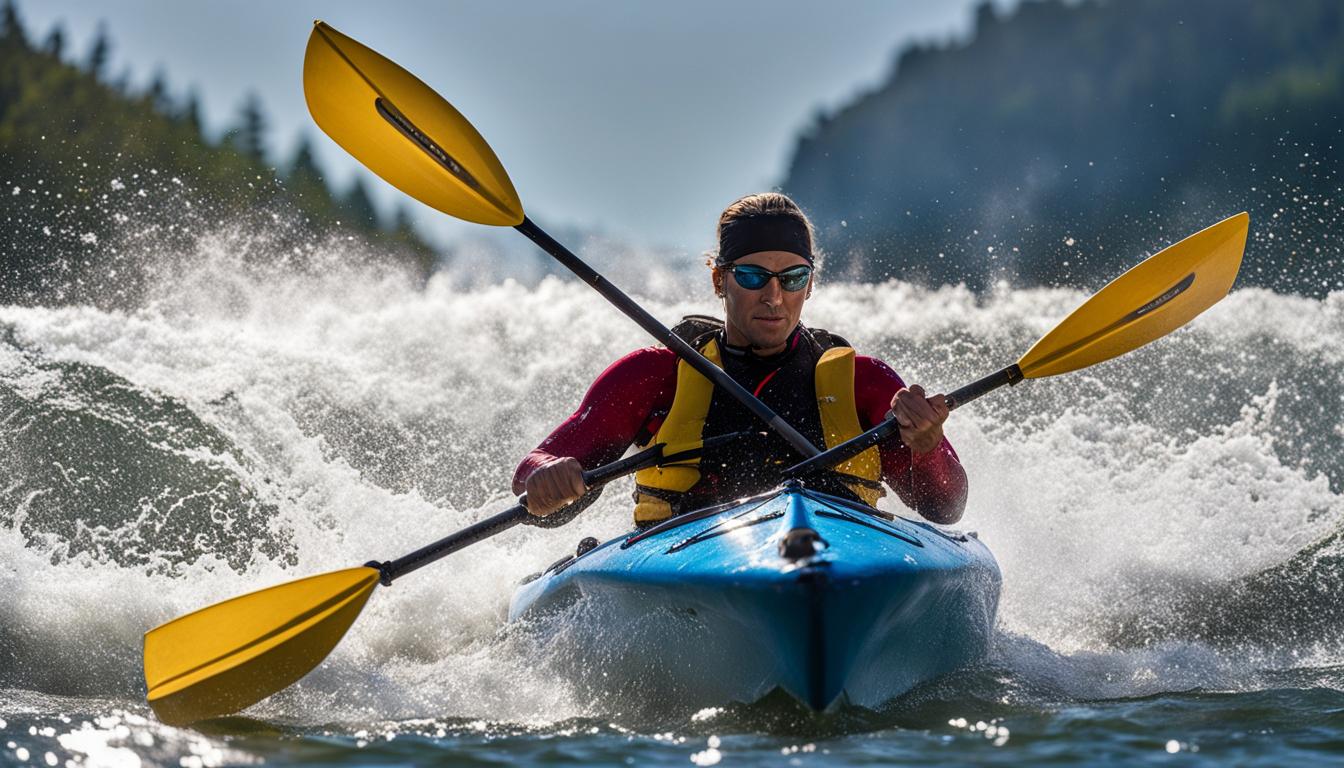Are you looking to take your kayaking performance to the next level? Interval training could be the key to unlocking your full potential on the water. Whether you’re a competitive athlete or a recreational enthusiast, incorporating high-intensity interval training (HIIT) into your routine can help improve your speed, endurance, and overall stamina in kayaking.
Interval training involves alternating periods of high-intensity exercise with periods of rest or lower intensity activity. This type of training has been proven to be highly effective in enhancing physical performance and improving physiological variables specific to kayaking.
By strategically structuring your interval workouts, you can target the specific aspects of paddling speed and stamina that you want to improve. Whether you’re aiming to increase your sprinting speed or enhance your endurance for long-distance paddling, interval training can be customized to suit your goals.
Key Takeaways:
- Interval training is a powerful tool for improving speed and stamina in kayaking.
- High-intensity interval training (HIIT) is particularly effective for kayakers.
- Interval workouts can be customized to target specific aspects of paddling speed and stamina.
- Integrate interval training into your routine gradually, increasing intensity and volume over time.
- Consistency and dedication are key to maximizing the benefits of interval training for kayaking.
The Benefits of Interval Training for Kayaking Performance
Interval training is a highly effective method for enhancing paddling performance in kayaking. By incorporating interval training routines into your training program, you can improve your speed, stamina, and overall performance on the water. Here are some key benefits of interval training for kayakers:
1. Enhanced Speed and Power
Interval training techniques, such as HIIT (high-intensity interval training), are known for their ability to improve anaerobic metabolism. This translates to increased speed and power in kayaking, allowing you to paddle faster and more efficiently. By pushing your limits during intense work intervals and allowing for adequate rest periods, you can optimize your body’s ability to generate power and propel your kayak with greater force.
2. Improved Aerobic Capacity
Paddling interval training routines also target the aerobic system, which is crucial for endurance in longer kayaking events. By alternating between high-intensity work intervals and active recovery periods, you can train and improve your aerobic capacity. This means that you’ll be able to sustain higher speeds for longer durations, giving you a competitive edge in races and other endurance paddling activities.
3. Specificity to Paddling Movements
Interval training can be tailored to mimic the movement patterns and intensity of kayaking, making it a highly specific form of training for paddlers. By incorporating paddle-specific exercises into your interval training routine, such as kettlebell swings and overhead presses, you can strengthen the muscles used in kayaking and improve your overall paddling technique. This targeted training approach can lead to significant improvements in your kayaking performance.
Overall, interval training offers numerous benefits for kayakers, including enhanced speed, power, aerobic capacity, and specificity to paddling movements. By incorporating interval training techniques into your training program, you can take your kayaking performance to the next level and achieve your goals on the water.

| Interval Training Technique | Training Intensity | Work-to-Rest Ratio | Primary Benefits |
|---|---|---|---|
| HIIT (High-Intensity Interval Training) | High | 1:1 or 2:1 | Improved speed, power, and anaerobic metabolism |
| Fartlek Training | Varied | Unstructured | Enhanced aerobic capacity and speed endurance |
| Tabata Training | Very high | 2:1 or 3:1 | Increased aerobic and anaerobic capacity |
Designing an Effective Interval Training Program for Kayaking
When it comes to improving speed and stamina in kayaking, an effective interval training program is crucial. By targeting the specific muscles used in paddling and gradually increasing the intensity and volume of training, you can build both strength and endurance for optimal performance on the water.
Key Muscle Groups to Target
When designing your interval training program, it’s important to focus on exercises that target the key muscle groups used in kayaking. These include the upper body muscles such as the shoulders, back, and arms, as well as the core muscles that provide stability and power.
Some exercises to incorporate into your program include kettlebell swings, which engage multiple muscle groups and mimic the paddling motion, cleans to build explosive power, and cable rows to strengthen the back and arms. By incorporating these exercises into your workouts, you can develop the specific strength and power required for kayaking.
Varying Intensity and Duration
In addition to targeting specific muscle groups, it’s important to incorporate flatwater sessions into your interval training program. These sessions should vary in intensity and duration, simulating the different demands of kayaking on the water.
For example, you can perform shorter, high-intensity intervals to improve speed and power, and longer, moderate-intensity intervals to build endurance. By varying the intensity and duration of your intervals, you can ensure that you’re challenging your body in different ways and preparing it for the demands of kayaking.
Gradual Progression for Continued Improvement
Lastly, to ensure continued improvement, it’s important to gradually increase the intensity and volume of your training over time. This progressive overload allows your body to adapt and continue making progress.
Start by incorporating shorter intervals at a moderate intensity, and as your fitness improves, gradually increase the duration and intensity of your intervals. Additionally, be sure to include adequate rest and recovery periods to allow your body to repair and rebuild.
By following these guidelines and designing a well-rounded interval training program, you can effectively build speed and stamina for kayaking. Remember to listen to your body, adjust the program as needed, and stay consistent in your training to achieve optimal results.

Combining Interval Training with Other Training Phases
Cross-training is an essential component of an effective training program for kayakers. By incorporating other activities into your training routine, you can improve your overall fitness and enhance your performance on the water. Cross-training helps develop additional strength, stability, and mobility, which are crucial for staying injury-free and performing at your best.
Diversify Your Workouts
When cross-training for kayak fitness, focus on activities that engage different muscle groups and movement patterns. This variety not only reduces the risk of overuse injuries but also enhances your overall physical capabilities. Consider incorporating activities such as swimming, cycling, yoga, or weightlifting into your training regimen. These exercises can help improve cardiovascular endurance, build muscular strength, and increase flexibility.
Additionally, participating in team sports like basketball or soccer can improve your agility and coordination, further enhancing your performance as a kayaker. The key is to choose activities that complement your kayaking training and address areas of weakness or limitation.
Recovery and Injury Prevention
Cross-training is also an excellent way to promote recovery and prevent injuries. Engaging in low-impact activities during recovery phases can help maintain fitness levels while allowing your body to rest and heal. Activities like swimming, yoga, or Pilates can provide gentle movement and promote blood flow to aid in recovery.
Furthermore, cross-training can help you identify and address muscle imbalances or weaknesses that may be hindering your kayaking performance. By working on these areas through targeted exercises, you can improve overall functional strength and reduce the risk of overuse injuries.
Ultimately, incorporating cross-training into your kayaking training program allows you to develop a well-rounded fitness foundation. By diversifying your workouts, promoting recovery, and addressing imbalances, you can optimize your overall fitness and enhance your performance as a kayaker.
Table: Benefits of Cross-Training for Kayakers
| Benefits | Description |
|---|---|
| Improved overall fitness | Engaging in different activities strengthens different muscle groups, enhances cardiovascular endurance, and increases flexibility. |
| Injury prevention | Cross-training helps identify and address muscle imbalances, reducing the risk of overuse injuries and promoting overall musculoskeletal health. |
| Enhanced recovery | Low-impact cross-training activities during recovery phases maintain fitness levels while promoting healing and reducing fatigue. |
| Improved agility and coordination | Participating in team sports or activities that require quick movements can enhance your agility and coordination, translating to improved performance on the water. |
By incorporating cross-training into your kayaking training program, you can achieve a well-rounded fitness foundation, reduce the risk of injuries, and optimize your performance as a kayaker.
Conclusion
Interval training is an essential component of any kayaker’s training program, offering significant benefits in optimizing performance on the water. By incorporating a well-designed interval training program into your routine, you can enhance your speed, stamina, and overall kayaking abilities.
High-intensity interval training (HIIT) is particularly effective in boosting kayaking performance. By utilizing ASR-based HIIT, you can target both aerobic and anaerobic metabolism, allowing you to excel in sprint kayak races and events lasting 1-5 minutes.
When designing your interval training program, consider incorporating a variety of paddle-specific exercises such as kettlebell swings, overhead presses, and goblet squats. Additionally, supplementing your training with flatwater sessions of varying intensity and duration can help improve your endurance.
Remember, consistency and gradual progression are key. By incorporating interval training into your year-long training plan, you can optimize your performance and achieve your goals as a kayaker. So, get ready to paddle your way to success with an interval training program tailored to your needs.
FAQ
What is interval training?
Interval training is a form of exercise that involves alternating between periods of high-intensity work and rest or lower-intensity activity.
Why is interval training effective for kayaking?
Interval training is effective for kayaking because it improves both aerobic and anaerobic metabolism, which are essential for optimal performance in sprint kayak races.
How does ASR-based HIIT improve sprint kayak performance?
ASR-based HIIT, which focuses on the anaerobic speed reserve, can effectively improve sprint kayak performance and related physiological variables.
What exercises can be included in a kayaking interval training program?
Exercises such as kettlebell swings, overhead presses, and goblet squats can be included in a kayaking interval training program to target key muscle groups used in kayaking.
How should the intensity and volume of training be increased over time?
It is important to gradually increase the intensity and volume of training over time to continue challenging the body and making progress.
How can interval training be combined with other training phases?
During the pre-competition and competition phases, the focus can shift more towards paddling-specific endurance while maintaining strength and power. Cross-training with other activities during the recovery phase can help improve stability, mobility, and flexibility.
How can kayakers maximize their performance on the water?
By incorporating interval training into a year-long training plan and designing a well-rounded program that includes a variety of exercises, kayakers can continue to improve their overall fitness and performance.





